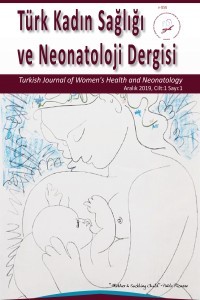Neonatal sepsis ve septik şokta serum iskemi modifiye albümin düzeyleri
İskemi modifiye albümin, yenidoğan, sepsis
Serum ischemia-modified albumin levels in neonatal sepsis and septic shock.
Ischemia modified albumin, newborn, sepsis,
___
- Ethan G. Leonard, Katherine Dobbs. Postnatal Bacterial İnfections. In: Martin RJ, Fanaroff AA, Walsh MC, editors. Fanaroff and Martin’s neonatal-perinatal medicine: diseases of the fetus and infant. 10th ed. St. Louis (MO): Elsevier Mosby; 2015. 734-750.
- Bizzarro MJ, Raskind C, Baltimore RS, Gallagher PG. Seventy-five years of neonatal sepsis at Yale: 1928-2003. Pediatrics. 2005 Sep; 116(3):595-602.
- Stoll BJ, Hansen NI, Sánchez PJ, Faix RG, Poindexter BB, Van Meurs KP, et al. National Institute of Child Health and Human Development Neonatal Research Network. Early onset neonatal sepsis: the burden of group B Streptococcal and E. coli disease continues. Pediatrics. 2011 Jan; 127(1):62-70.
- Kermorvant-Duchemin E, Laborie S, Rabilloud M, Lapillonne A, Claris O. Outcome and prognostic factors in neonates with septic shock. Pediatr Crit Care Med. 2008 Mar;9(2):186-91.
- Nguyen HB, Rivers EP, Abrahamian FM, Moran GJ, Abraham E, Trzeciak Set et al. Severe sepsis and septic shock: review of the literature and emergency department management guidelines. Ann Emerg Med. 2006 Jul;48(1):28-54.
- Dominguez-Rodriguez A, Abreu-Gonzalez P. Current role of ischemia-modified albumin in routine clinical practice. Biomarkers. 2010 Dec;15(8):655-62
- Sinha MK, Roy D, Gaze DC, Collinson PO, Kaski JC. Role of "Ischemia modified albumin", a new biochemical marker of myocardial ischaemia, in the early diagnosis of acute coronary syndromes. Emerg Med J. 2004 Jan;21(1):29-34.
- Kaefer M, Piva SJ, De Carvalho JA, Da Silva DB, Becker AM, Coelho AC, et al. Association between ischemia modified albumin, inflammation and hyperglycemia in type 2 diabetes mellitus. Clin Biochem. 2010 Mar;43(4-5):450-4.
- Kotani K, Caccavello R, Sakane N, Miyamoto M, Gugliucci A. Influence of ezetimibe monotherapy on ischemia-modified albumin levels in hypercholesterolemic patients. Pharmacol Rep. 2011;63(5):1248-51.
- Mehmetoglu I, Yerlikaya FH, Kurban S, Erdem SS, Tonbul Z. Oxidative stress markers in hemodialysis and peritoneal dialysis patients, including coenzyme Q10 and ischemia-modified albumin. Int J Artif Organs. 2012 Mar;35(3):226-32.
- Dursun A, Okumus N, Zenciroglu A. Ischemia-modified albumin (IMA): could it be useful to predict perinatal asphyxia? J Matern Fetal Neonatal Med. 2012 Nov;25(11):2401-5.
- Gugliucci A, Hermo R, Monroy C, Numaguchi M, Kimura S. Ischemia-modified albumin levels in cord blood: a case-control study in uncomplicated and complicated deliveries. Clin Chim Acta. 2005 Dec;362(1-2):155-60.
- Yakut I, Tayman C, Oztekin O, Namuslu M, Karaca F, Kosus A. Ischemia-modified albumin may be a novel marker for the diagnosis and follow-up of necrotizing enterocolitis. J Clin Lab Anal. 2014 May;28(3):170-7.
- Oztekın O, Kalay S, Tayman C, Namuslu M, Celık HT. Levels of ischemia-modified albumin in transient tachypnea of the newborn. Am J Perinatol. 2015 Feb;30(2):193-8
- Yerlikaya FH, Kurban S, Mehmetoglu I, Annagur A, Altunhan H, Erbay E, et al. Serum ischemia-modified albumin levels at diagnosis and during treatment of late-onset neonatal sepsis. J Matern Fetal Neonatal Med. 2014 Nov;27(17):1723-7.
- Erol S, Unal S, Demirel N, et al. Evaluation of serum ischemia-modified albumin levels in anemia of prematurity. J Matern Fetal Neonatal Med 2018; 31:3133-3138.
- Zuwała-Jagiełło J1, Warwas M, Pazgan-Simon M. Ischemia-modified albumin (IMA) is increased in patients with chronic hepatitis C infection and related to markers of oxidative stress and inflammation. Acta Biochim Pol. 2012;59(4):661-7.
- Goldstein B, Giroir B, Randolph A; International Consensus Conference on Pediatric Sepsis. International pediatric sepsis consensus conference: definitions for sepsis and organ dysfunction in pediatrics. Pediatr Crit Care Med. 2005 Jan; 6(1):2-8.
- Bar-Or D, Lau E, Winkler JV. A novel assay for cobalt-albumin binding and its potential as a marker for myocardial ischemia-a preliminary report. J Emerg Med. 2000 Nov; 19(4):311-5.
- Lippi G, Montagnana M, Salvagno GL, Guidi GC. Standardization of ischemia-modified albumin testing: adjustment for serum albumin. Clin Chem Lab Med. 2007;45(2):261-2.
- Sbarouni E, Georgiadou P, Voudris V. Ischemia modified albumin changes - review and clinical implications. Clin Chem Lab Med. 2011 Feb;49(2):177-84.
- Erdem SS, Yerlikaya FH, Çiçekler H, Gül M. Association between ischemia-modified albumin, homocysteine, vitamin B(12) and folic acid in patients with severe sepsis. Clin Chem Lab Med. 2012 Feb 14;50(8):1417-21.
- Iacovidou N, Briana DD, Boutsikou M, Liosi S, Baka S, Boutsikou T, et al. Cord blood ischemia-modified albumin levels in normal and intrauterine growth restricted pregnancies. Mediators Inflamm. 2008;2008:523081.
- Silveira RD, Giacomini C, Procianoy RS. Neonatal sepsis and septic shock: concepts update and review. Rev Bras Ter Intensiva. 2010 Sep;22(3):280-290.
- Lever A, Mackenzie I. Sepsis: definition, epidemiology, and diagnosis. BMJ. 2007 Oct 27;335(7625):879-83.
- Buttery JP. Blood cultures in newborns and children: optimising an everyday test. Arch Dis Child Fetal Neonatal Ed. 2002 Jul;87(1):F25-8. Review.
- Chiesa C, Natale F, Pascone R, Osborn JF, Pacifico L, Bonci E, et al. C reactive protein and procalcitonin: reference intervals for preterm and term newborns during the early neonatal period. Clin Chim Acta. 2011 May 12;412(11-12):1053-9.
- Bhandari V. Effective Biomarkers for Diagnosis of Neonatal Sepsis, Journal of the Pediatric Infectious Diseases Society, Volume 3, Issue 3, September 2014, Pages 234–245.
- Başlangıç: 2019
- Yayıncı: Sağlık Bilimleri Üniversitesi Etlik Zübeyde Hanım Kadın Hastalıkları Eğitim ve Araştırma Hastanesi
IVF tedavisinde maternal yaşın önemi
Neonatal sepsis ve septik şokta serum iskemi modifiye albümin düzeyleri
Dilek ULUBAS, Ayşen Sumru KAVURT, Ozge AYDEMİR, Ahmet Yağmur BAŞ, Nihal DEMİREL
Polikistik over sendromunda anti-mullerian hormon ve vitamin D düzeylerinin değerlendirilmesi
Senem ARDA DÜZ, Görkem TUNCAY, Abdullah KARAER
İlker SELCUK, Burak ERSAK, Fatih KILIÇ, Atahan TOYRAN, Seda ŞAHİN AKER, Bülent ÖZDAL, Hakan Raşit YALÇIN
Özlem SEÇİLMİŞ KERİMOĞLU, Huriye EZVECİ
Mol evakuasyonu sonrası trofoblastik pulmoner emboli: Olgu sunumu
Demet AYDOĞAN KIRMIZI, Emre BAŞER, Taylan ONAT, Melike DEMİR ÇALTEKİN, Ethem Serdar YALVAÇ
Kadın hastalıkları ve doğum pratiğinde SARS-COV-2 (COVID-19) enfeksiyonu ile ilgili güncel bilgiler
